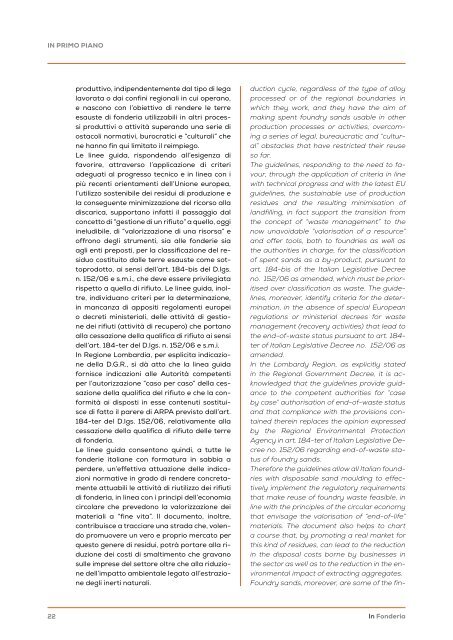In Fonderia 2 2024
Secondo numero del 2024 di In Fonderia
Secondo numero del 2024 di In Fonderia
You also want an ePaper? Increase the reach of your titles
YUMPU automatically turns print PDFs into web optimized ePapers that Google loves.
IN PRIMO PIANO<br />
produttivo, indipendentemente dal tipo di lega<br />
lavorata o dai confini regionali in cui operano,<br />
e nascono con l’obiettivo di rendere le terre<br />
esauste di fonderia utilizzabili in altri processi<br />
produttivi o attività superando una serie di<br />
ostacoli normativi, burocratici e “culturali” che<br />
ne hanno fin qui limitato il reimpiego.<br />
Le linee guida, rispondendo all’esigenza di<br />
favorire, attraverso l’applicazione di criteri<br />
adeguati al progresso tecnico e in linea con i<br />
più recenti orientamenti dell’Unione europea,<br />
l’utilizzo sostenibile dei residui di produzione e<br />
la conseguente minimizzazione del ricorso alla<br />
discarica, supportano infatti il passaggio dal<br />
concetto di “gestione di un rifiuto” a quello, oggi<br />
ineludibile, di “valorizzazione di una risorsa” e<br />
offrono degli strumenti, sia alle fonderie sia<br />
agli enti preposti, per la classificazione del residuo<br />
costituito dalle terre esauste come sottoprodotto,<br />
ai sensi dell’art. 184-bis del D.lgs.<br />
n. 152/06 e s.m.i., che deve essere privilegiata<br />
rispetto a quella di rifiuto. Le linee guida, inoltre,<br />
individuano criteri per la determinazione,<br />
in mancanza di appositi regolamenti europei<br />
o decreti ministeriali, delle attività di gestione<br />
dei rifiuti (attività di recupero) che portano<br />
alla cessazione della qualifica di rifiuto ai sensi<br />
dell’art. 184-ter del D.lgs. n. 152/06 e s.m.i.<br />
<strong>In</strong> Regione Lombardia, per esplicita indicazione<br />
della D.G.R., si dà atto che la linea guida<br />
fornisce indicazioni alle Autorità competenti<br />
per l’autorizzazione “caso per caso” della cessazione<br />
della qualifica del rifiuto e che la conformità<br />
ai disposti in esse contenuti sostituisce<br />
di fatto il parere di ARPA previsto dall’art.<br />
184-ter del D.lgs. 152/06, relativamente alla<br />
cessazione della qualifica di rifiuto delle terre<br />
di fonderia.<br />
Le linee guida consentono quindi, a tutte le<br />
fonderie italiane con formatura in sabbia a<br />
perdere, un’effettiva attuazione delle indicazioni<br />
normative in grado di rendere concretamente<br />
attuabili le attività di riutilizzo dei rifiuti<br />
di fonderia, in linea con i principi dell’economia<br />
circolare che prevedono la valorizzazione dei<br />
materiali a “fine vita”. Il documento, inoltre,<br />
contribuisce a tracciare una strada che, volendo<br />
promuovere un vero e proprio mercato per<br />
questo genere di residui, potrà portare alla riduzione<br />
dei costi di smaltimento che gravano<br />
sulle imprese del settore oltre che alla riduzione<br />
dell’impatto ambientale legato all’estrazione<br />
degli inerti naturali.<br />
duction cycle, regardless of the type of alloy<br />
processed or of the regional boundaries in<br />
which they work, and they have the aim of<br />
making spent foundry sands usable in other<br />
production processes or activities, overcoming<br />
a series of legal, bureaucratic and “cultural”<br />
obstacles that have restricted their reuse<br />
so far.<br />
The guidelines, responding to the need to favour,<br />
through the application of criteria in line<br />
with technical progress and with the latest EU<br />
guidelines, the sustainable use of production<br />
residues and the resulting minimisation of<br />
landfilling, in fact support the transition from<br />
the concept of “waste management” to the<br />
now unavoidable “valorisation of a resource”<br />
and offer tools, both to foundries as well as<br />
the authorities in charge, for the classification<br />
of spent sands as a by-product, pursuant to<br />
art. 184-bis of the Italian Legislative Decree<br />
no. 152/06 as amended, which must be prioritised<br />
over classification as waste. The guidelines,<br />
moreover, identify criteria for the determination,<br />
in the absence of special European<br />
regulations or ministerial decrees for waste<br />
management (recovery activities) that lead to<br />
the end-of-waste status pursuant to art. 184-<br />
ter of Italian Legislative Decree no. 152/06 as<br />
amended.<br />
<strong>In</strong> the Lombardy Region, as explicitly stated<br />
in the Regional Government Decree, it is acknowledged<br />
that the guidelines provide guidance<br />
to the competent authorities for “case<br />
by case” authorisation of end-of-waste status<br />
and that compliance with the provisions contained<br />
therein replaces the opinion expressed<br />
by the Regional Environmental Protection<br />
Agency in art. 184-ter of Italian Legislative Decree<br />
no. 152/06 regarding end-of-waste status<br />
of foundry sands.<br />
Therefore the guidelines allow all Italian foundries<br />
with disposable sand moulding to effectively<br />
implement the regulatory requirements<br />
that make reuse of foundry waste feasible, in<br />
line with the principles of the circular economy<br />
that envisage the valorisation of “end-of-life”<br />
materials. The document also helps to chart<br />
a course that, by promoting a real market for<br />
this kind of residues, can lead to the reduction<br />
in the disposal costs borne by businesses in<br />
the sector as well as to the reduction in the environmental<br />
impact of extracting aggregates.<br />
Foundry sands, moreover, are some of the fin-<br />
22<br />
<strong>In</strong> <strong>Fonderia</strong>














